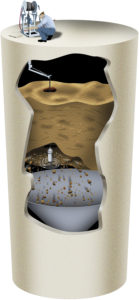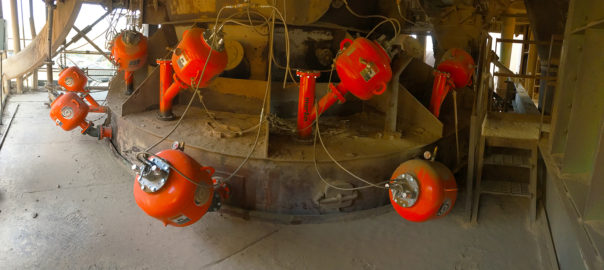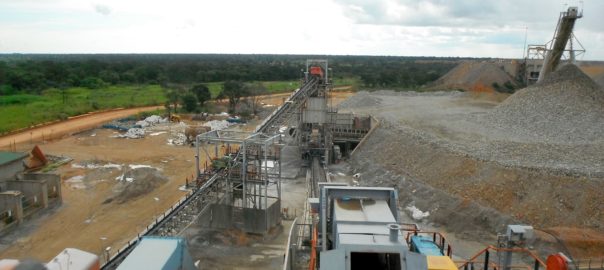Accumulation or blockages in storage systems and build-up in process vessels at mine sites can impede material movement, causing bottlenecks that interfere with equipment performance, reduces process efficiency and put a choke hold on an operation’s profitability, according to Martin Engineering.
Efficient material flow is a critical element of wet mining processes such as stoping, hydraulic mining and wet dredging, the company says. Poor material flow also raises maintenance expenses, diverting manpower from core activities and, in some cases, introducing safety risks for personnel.
“Most systems suffer from some amount of accumulation on vessel walls, which can rob plant owners of the storage systems in which they’ve invested,” Brad Pronschinske, Global Director of Air Cannons Business Group for Martin Engineering, said. “These buildups reduce material flow, decreasing the ‘live’ capacity of the vessel and the efficiency of the bulk handling system overall.”
Pronschinske said the accumulations tend to take one of several forms: arches, plugs, build-ups or “rat holes”.
He added: “If they become severe enough, flow problems can bring production to a complete stop.”
Although many plants still use manual techniques to remove buildup, the cost of labour and periodic shutdowns has led some producers to investigate more effective methods for dealing with this common production issue, according to the company.
Buildup versus throughput
Even well-designed processes can experience accumulations, which have a significant impact on output and profitability. Changes in process conditions, raw materials or weather can all influence material flow, and even small amounts of accumulation can grow into a serious blockage.
Beyond moisture content, there are many causes of raw material buildup on vessel walls, according to Martin Engineering.
Some metals contain naturally occurring magnetic properties; nearly 90% of the earth’s crust contains silica, and the sharp crystalline structure can contribute to buildup. Other factors can include the surface friction of the silo walls, the shape of the vessel, the angle of the slope and the size of the material being loaded.
Lost production is probably the most conspicuous cost of these flow problems, according to the company, but the expense can become apparent in a variety of other ways.
Shutdowns to clear the restricted flow cost valuable process time and maintenance hours, while wasting energy during re-start. Refractory walls can be worn or damaged by tools or cleaning techniques. When access is difficult, removing material blockages may also introduce safety risks for personnel. Scaffolds or ladders might be needed to reach access points, and staff can risk exposure to hot debris, dust or gases when chunks of material are released.
Many of the most common problem areas for accumulation are classified as confined spaces, requiring a special permit for workers to enter and perform work.
“The consequences of untrained or inexperienced staff entering a silo or hopper can be disastrous, including physical injury, burial and asphyxiation,” Martin Engineering says. “Disrupted material adhered to the sides of the vessel can suddenly break loose and fall on a worker. If the discharge door is in the open position, cargo can suddenly evacuate, causing unsecured workers to get caught in the flow. Cleaning vessels containing combustible dust – without proper testing, ventilation and safety measures – could even result in a deadly explosion.”
Getting professional help
“While some large facilities choose to make the capital investment to purchase their own cleaning gear to clear process equipment and storage vessels – as well as train personnel – others are finding it more sensible to schedule regular cleanings by specially-trained contractors,” Pronschinske says. “Given the costs of labour, lost time and potential risk to employees, this can often be accomplished for less than the total investment of in-house cleanouts.”

from the top, controlled by personnel outside
At one location, for example, the blockage was so severe in one silo that it had been out of use for years. While it took the outside contractor almost two weeks to fully evacuate the vessel, the process restored 3,500 tons (3,175 t) of storage capacity, according to the company.
At another facility, the crew was able to remove enough ‘lost’ product that the value of the recovered material actually paid for the cost of the cleaning.
“In short, regular cleaning of storage vessels can quickly turn into an economic benefit – not an expense, but rather an investment with a measurable return on investment,” the company says.
The costs of cleaning
There are a few types of equipment used for this purpose.
“One operates like an industrial-strength ‘weed whip’ rotating a set of flails against the material in the vessel,” Martin Engineering says. “This approach eliminates the need for confined space entry and hazardous cleaning techniques, typically allowing the material to be recaptured and returned to the process stream.”
The whip can be set up quickly outside the vessel, and it is portable enough to move easily around various bin sizes and shapes, according to the company. Typically lowered into the vessel from the top and then working from the bottom up to safely dislodge accumulation, the pneumatic cutting head delivers powerful cleaning action to remove buildup from walls and chutes without damaging the refractory.
Technicians lower the device all the way down through the topside opening, then start at the bottom of the buildup and work their way up, undercutting the wall accumulation as it falls by its own weight, the company explains. “In extreme cases, a ‘bin drill’ can be used to clear a 12 in (305 mm) pathway as deep as 150 ft (45 m) to start the process.”
Flow aids
Regular cleaning is one approach to keeping materials flowing freely by removing buildups from silo walls, but there are other flow aids which may reduce the need for cleaning or even eliminate it, according to Martin Engineering.

One method is through industrial vibrators designed for bin and chute applications.
“Electric vibrators are generally the most efficient, delivering the longest life, low maintenance and low noise,” it said. “The initial cost for an electric vibrator is higher than for pneumatic designs, but the operating cost is lower. Turbine vibrators are the most efficient and quietest of the pneumatic designs, making them well suited to applications in which low noise, high efficiency and low initial cost are desired.”
Air cannons (pictured) are another approach to maintaining good material flow, according to the company, particularly in larger vessels. Also known as an air blaster, the air cannon is a flow aid device that can be found in mining, coal handling and many other industries. Applications vary widely, from emptying bulk material storage vessels to purging boiler ash to cleaning high-temperature gas ducts.
“In the mining industry, air cannons are frequently specified to eliminate build-ups in hoppers, storage vessels, transfer chutes, bins and other production bottlenecks,” the company said. “They can also be found in mineral processing plants where metals are extracted using processes creating slurries and other wet, tacky tailings.”
Air cannon technology has been used in mining and material processing for many years, helping to improve flow and reduce maintenance, according to the company. The timed discharge of a directed air blast can prevent accumulation or blockages that reduce process efficiency and raise maintenance expenses.
In underground mines with potentially explosive dust, manual firing of cannons without the use of electrical solenoids is an option, the company says. “By facilitating flow and minimising build-up, air cannons help bulk material handlers minimise the need for process interruptions and manual labour,” Martin Engineering claims.
The two basic components of an air cannon are a fast-acting, high-flow valve and a pressure vessel (tank). The device performs work when compressed air (or some other inert gas) in the tank is suddenly released by the valve and directed through a nozzle, which is strategically positioned in the tower, duct, chute or other location. Often installed in a series and precisely sequenced for maximum effect, the network can be timed to best suit individual process conditions or material characteristics, the company says.
Pronschinske concluded: “The core message for mines and material processors is that they don’t have to put up with accumulation problems and the additional expenses they can cause. There are a number of approaches that can help resolve those issues before they turn into expensive downtime, lost material and safety hazards.”








